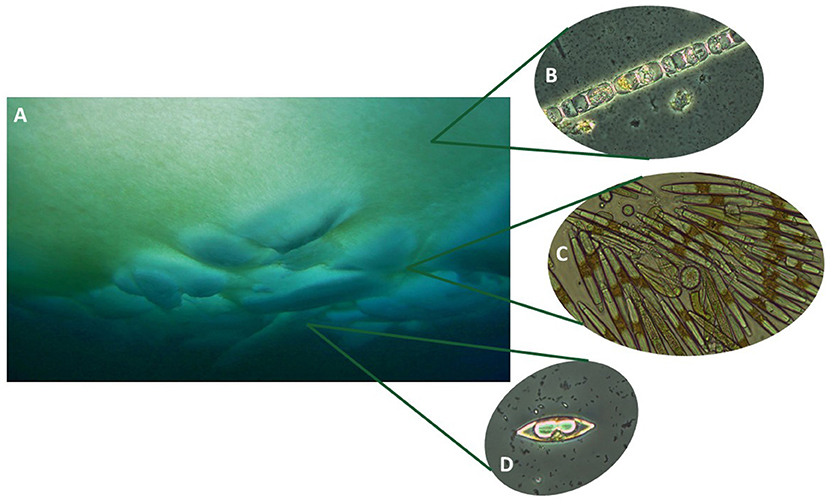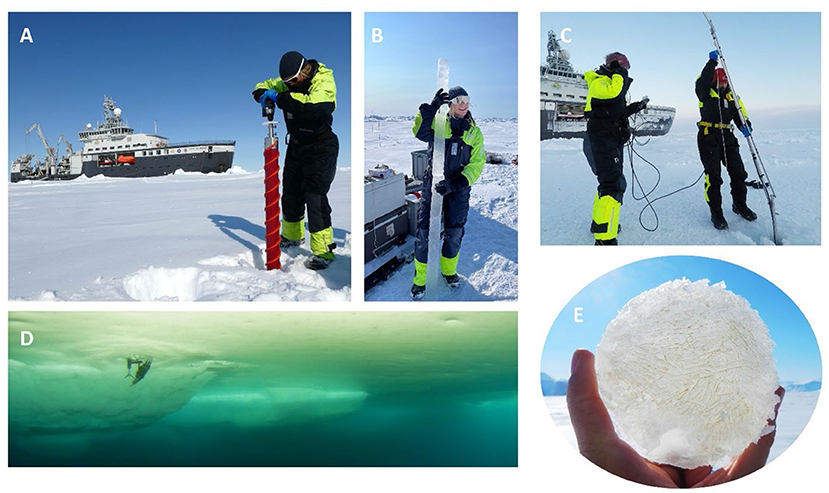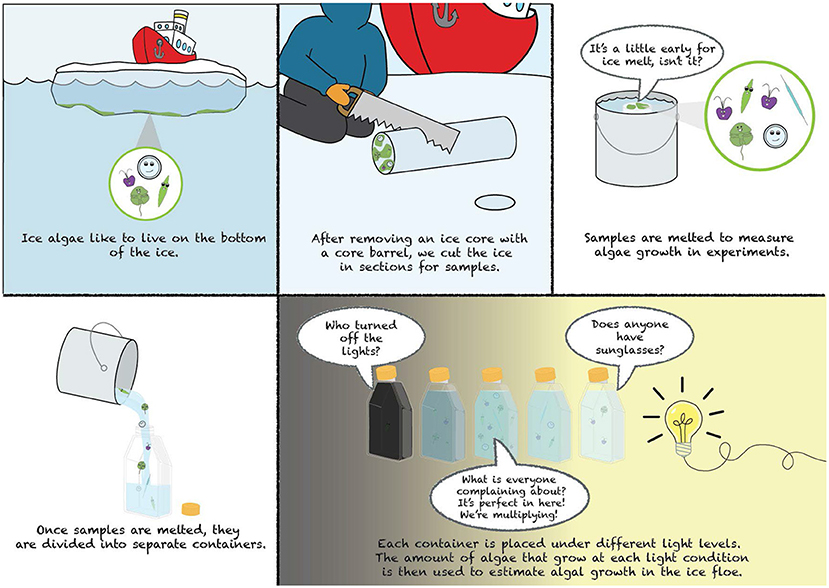Abstract
Sea ice in the Arctic and Antarctic is home to microscopic algae that form the base of the food chain in polar marine ecosystems. Scientists investigate these algae by collecting samples from the sea ice and the water below. To understand the natural environment where the algae live, instruments are used to measure the light above and below the ice. The amount of nutrients in the sea ice and water are also measured, as nutrients are essential for algal growth. The collected algae can be grown in the laboratory, where scientists can see how changes in conditions like light affect their growth. How well the algae grow is an indication of their health. The health of sea-ice algae is a key indicator of the health of the entire polar marine ecosystem.
Sea Ice is Home for Tiny Organisms
The frozen ocean waters of the Arctic and Antarctic host an exciting and diverse ecosystem, which is home to many types of living organisms [1]. Some are as large as whales, while others, like sea-ice algae, are very tiny, smaller than a grain of sand. Sea-ice algae mostly live at the bottom of the sea ice, where it meets the ocean below (Figure 1). Just like plants on land, sea-ice algae use sunlight to make food and oxygen through a process called photosynthesis. Often, many types of algae grow together with bacteria, which helps them to share the nutrients and energy they need to grow.

- Figure 1 - Sea-ice algae live within and at the bottom of the sea ice.
- From far away, they look like green fluff underneath the ice (A) but under the microscope we see the diverse shapes and sizes of each algae (B–D). Photo credits: (A) Janina Osanen, Norwegian University of Science and Technology; (B) Megan Lenss, UiT The Arctic University of Norway; (C) and (D) Karley Campbell, UiT The Arctic University of Norway, Megan Lenss, UiT The Arctic University of Norway.
Sea-ice algae are very important because they are at the base of the food web in polar regions. Small animals that live within the sea ice, called ice fauna, eat sea-ice algae. Ice fauna are then eaten by small fish, and those small fish are an important food source for larger animals, like seals. This means that sea-ice algae are ultimately a food source for many animals in the polar ecosystem. However, polar ecosystems are quickly changing because of climate change. Warmer waters and less ice affect the algae communities in several ways. For example, warmer temperatures can make the algae grow faster or slower, and they melt the icy homes of the algae, so these organisms have nowhere to live [2].
Sea-Ice Check Up
Scientists closely monitor changes in the polar regions by checking up on the ice algae communities. One method of doing this is by taking sea-ice core(s) (Figure 2). Ice cores are pieces of sea ice made with a tool called a core barrel. The core barrel is a one-meter-long tube with sharp metal blades at the bottom, attached to a powerful drill. The drill rotates the barrel quickly to cut into the ice. Once the ice is cut all the way down to the seawater, the sea-ice core(s) is carefully removed from the core barrel and cut into smaller sections using a hand saw. Each section is stored in a labeled container in a cool, shaded environment, similar to the algae’s natural habitat.

- Figure 2 - Sampling ice algae requires scientists to: (A) drill through the ice, and (B) pull out an ice core that can be taller than the scientist! (E) With some luck, the bottom of the core has some algae living between the ice crystals.
- (D) The movement of water under the ice can be studied using a sensor that is inserted under the ice to detect water movement. (C) Similarly, checking how bright or dark it is under the ice can be achieved by lowering a light sensor under the ice, often using a metal arm.
Scientists collect sea-ice core(s) to answer several types of questions, such as how many algae are living in ice, how salty the ice is, and what the temperature is inside the ice. They also measure the length of the core, the depth of the snow on top of the ice, and the thickness of the sea ice. The sea ice that the algae live in is around 1–5 m thick with 5–50 cm of snow sitting on top.
Growing Sea-Ice Algae
After collecting the sea-ice core(s), scientists take them to the laboratory where the cores are melted and used for further study. Scientists can then perform experiments on algae grown in the lab (Figure 3). These experiments help scientists understand how algae grow under different conditions [3]. While algae face extreme light, temperature, and salinity (saltiness) conditions in their natural environment, certain conditions are better for their growth. When growth conditions are good, sea-ice algae can grow very fast, but when conditions are poor, like when there are not enough nutrients, algae can become stressed and stop growing.

- Figure 3 - Scientists can perform experiments in which sea-ice algae communities collected from melted sea-ice core(s) are placed in special bottles.
- The algae are given nutrients to help them grow and the bottles are lined up in front of a light bulb. The algae are left to grow for several hours. Then the scientists measure how much the algae have grown and use this measurement to calculate a growth rate, meaning how fast the algal cells divide.
Algae experiments involve placing the melted sea-ice core(s) samples into special bottles and allowing the algae to grow, like potting a houseplant. The bottles are kept in temperature and salinity conditions that resemble the natural habitat where the algae were sampled. The algae’s growth is observed under varying light conditions. How quickly the algae grow helps determine their fitness and the environmental factors that support or limit their growth.
Light and Sea-ice Algae
Understanding the light conditions for the experiments requires first measuring the light available to the algae in their natural environment. The light environment underneath the sea ice is measured using a sensor that looks like a pear-shaped light bulb [4]. The shape of the instrument allows it to measure light from all directions, mimicking how the algae experience the light. It is important to measure light from all directions because the light bounces around in the ice, and in the water below the ice, before reaching the algae.
To get the instrument underneath the thick sea ice, it is attached to a long metal arm (Figure 2C). The scientists first make a hole in the ice and then lower the metal arm, with the instrument attached, down through the hole and into the water. Once the instrument is in the water, the metal arm is bent into an L-shape and positioned beneath the sea ice close to the algae.
The amount of light available to the algae depends on the season and the thickness of the sea ice and the snow. Thicker ice blocks more light from reaching the algae at the bottom. The amount of snow on top of the ice also plays a key role. Just like you feel cooler wearing a white T-shirt on a sunny day rather than a black one, white snow laying on top of the sea ice reflects most of the light coming from the sun and reduces the amount reaching the algae. The amount of light that reaches the algae at the bottom of the ice is much lower than the light above the ice. In other words, the sea ice and snow shade what is below, including the sea-ice algae.
Vitamins for Sea-Ice Algae
Apart from the light environment, scientists are also interested in the amount of nutrients at the bottom of the sea ice. Nutrients describe substances that are vital for algae to grow, almost like the vitamins in the foods that you eat. It is important that algae receive a “balanced diet” with the right amount of nutrients for growth. Nutrients found in the sea ice come from the ocean below. How do they get in to the sea ice? Up-and-down movements in the water push the nutrients into the sea ice.
Scientists place an instrument in the water underneath the ice that measures how much water moves up and down below the sea ice (Figure 2D). These measurements help calculate the amount of nutrients reaching the sea-ice algae. Scientists also take measurements of the amount of nutrients in the water under the ice and in the sea ice. They do this by collecting under-ice water samples through a hole in the ice and sea-ice samples using the core barrel. These samples are then analyzed in the laboratory to measure nutrients in the water and the ice [5].
It is amazing how sea-ice algae can thrive in one of the planet’s most extreme environments, within the sea ice! To grow best, sea-ice algae need the right balance of light and nutrients. However, as the polar regions are warming due to climate change, the sea ice they live in is undergoing major changes, impacting the growing conditions of the sea-ice algae. To assess the health of the algae, scientists travel to the polar regions to take sea-ice core(s), do experiments, and measure conditions using specialized instruments. The data gathered during field expeditions allow scientists to check the health of the algae. As algae form the base of the food web in the polar regions, the health of the algae is a key indicator of the health of the entire ecosystem in the Arctic and Antarctic.
Glossary
Ecosystem: ↑ A community of living organisms, including plants and animals, that interact with each other and with their non-living environment, like air and water, to form a system that supports life.
Sea-ice Algae: ↑ One-celled photosynthetic organisms that live on and within the sea ice in polar regions.
Nutrients: ↑ Substances that provide essential nourishment for growth and survival of plants and animals. These include elements like nitrogen, phosphorus, and iron.
Climate Change: ↑ The long-term warming of Earth caused by pollution, like carbon dioxide, trapping heat and leading to problems like stronger storms and melting ice.
Sea-ice Core: ↑ A long tube of ice that is drilled out from frozen ocean water.
Core Barrel: ↑ A special tool used by scientists to collect sea-ice cores. It looks like a big tube with sharp blades at the bottom with a drill attached at the top.
Salinity: ↑ How salty something is. When we are talking about sea ice, the salinity describes the amount of salt within the ice.
Conflict of Interest
The authors declare that the research was conducted in the absence of any commercial or financial relationships that could be construed as a potential conflict of interest.
Acknowledgments
This work is a contribution to the Research Council of Norway funded project BREATHE (Bottom sea ice Respiration and nutrient Exchanges Assessed for THE Arctic, 325405) project.
References
[1] ↑ Arrigo, K. R. 2014. Sea ice ecosystems. Ann. Rev. Mar. Sci. 6:439–467. doi: 10.1146/annurev-marine-010213-135103
[2] ↑ van Leeuwe M. A., Tedesco, L., Arrigo, K. R., Assmy, P., Campbell, K., Meiners, K. M., et al., 2018. Microalgal community structure and primary production in Arctic and Antarctic sea ice: a synthesis. Elementa 6:4. doi: 10.1525/elementa.267
[3] ↑ Campbell, K., Mundy, C. J., Landy, J. C., Delaforge, A., Michel, C., and Rysgaard, S. 2016. Community dynamics of bottom-ice algae in Dease Strait of the Canadian Arctic. Progr. Oceanogr. 149:27–39. doi: 10.1016/j.pocean.2016.10.005
[4] ↑ Lange, B. A., Haas, C., Charette, J., Katlein, C., Campbell K., Duerksen, S., et al., 2019. Contrasting ice algae and snow-dependent irradiance relationships between first-year and multiyear sea ice. Geophys. Res. Lett. 46:10834–10843. doi: 10.1029/2019GL082873
[5] ↑ Miller, L. A., Fripiat, F., Else, B. G. T., Bowman, J. S., Brown, K. A., Eric Collins, R., et al., 2015. Methods for biogeochemical studies of sea ice: the state of the art, caveats, and recommendations. Elementa 3:000038. doi: 10.12952/journal.elementa.000038
